How much do you know about our coral reefs?
Contrary to what many people assume, coral aren’t plants – they’re animals. Corals have tiny, tentacle-like arms that they use to capture their food from the water. They are one of the most interesting creatures that inhabit the ocean – but they are more than just beauty. In this article, we will learn more about corals and what makes them so special.
25% of ocean life is supported by corals
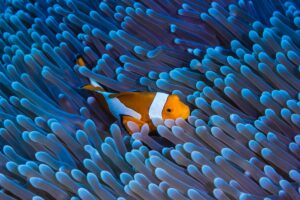
Coral Reefs are frequently referred to as the “rainforests of the sea” due to the richness of life that can be found there. Over 4,000 different species of fish and 25% of all marine life are thought to depend on coral reefs at some stage in their life cycles.
Fish, corals, lobsters, clams, seahorses, sponges, and sea turtles are only a few of the thousands of creatures that rely on reefs for their survival.
Coral reefs grow very slowly, at an average rate of just 0.078 inch per year
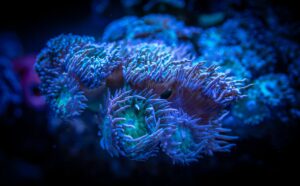
Corals grow gradually. They can develop at a rate of less than 0.078 inches (2millimeters) per year and as much as 3.93 inches per year, depending on the variety. It may even take up to 10,000 years for a coral reef to form from a group of larvae and even the fastest-growing coral species grow at a frustratingly slow pace.
The “massive corals” are the slowest growing species, adding between 0.2–1 inch ( 5 to 25 millimeters )per year to their length.
Corals outlived dinosaurs
Corals are estimated to be around 500 million years old, and they have existed since the time of the dinosaurs. Appearing as solitary forms in the fossil record more than 400 million years ago, corals are extremely ancient animals that evolved into modern reef-building forms over the last 25 million years.
At more than 4,000 years old, the deep-water black coral is the oldest living skeletal-accreting marine organism known.
Coral reefs have the potential to become so huge that they may be seen from space
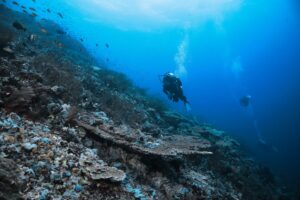
The Great Barrier Reef located in Australia consists of about 3,000 individual reefs of coral and it is the only living structure that can be seen from space, stretches for around 1,243 miles (2,000 kilometers) and covers an area of about 135,136 square miles (350,000 square kilometers).
Millions of microscopic organisms make up and construct this reef structure.
There Are Different Types Of Coral Reefs
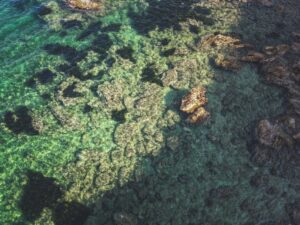
The most common type of reef is the fringing reef. Fringing coral reefs develop close to the shorelines of continents and islands. The largest fringing coral reef in the world is the Ningaloo Reef, stretching to around 160 miles (260 km) along the coastline of Western Australia.
Barrier reefs are extensive linear reef complexes that parallel a shore, and are separated from it by lagoon. Barrier reefs with shallow lagoons can occasionally resemble fringing reefs, but they differ from them because of where they came from and because they typically have deeper lagoons.
Atolls are corals that are typically found in the middle of the ocean. The largest atoll coral is called the Kiritimati Atoll, also called Christmas Atoll, coral island in the Northern Line Islands, part of Kiribati, in the west-central Pacific Ocean. It is the largest island of purely coral formation in the world, having a circumference of about 100 miles (160 km).
Scientists have been examining coral reefs for more than 300 years
Corals can treat cancer
Coral Reefs Help To Filter And Improve The Quality Of Seawater
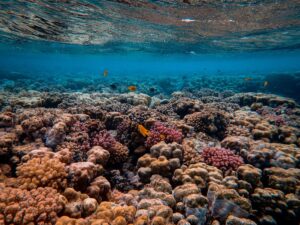
Numerous sponges and corals are filter feeders, which means they ingest particulate debris, or contaminants that do not dissolve in water. This stops these specks from sinking to the ocean’s bottom and contaminating it with dangerous substances.
Corals are extremely fragile
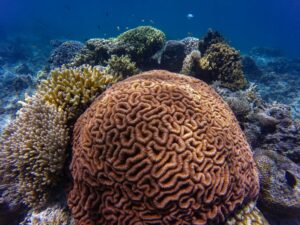
Coral reefs are among the planet’s most diversified ecosystems, yet they are also among its most vulnerable. These habitats are experiencing significant stress and decline as a result of human activity, rising water temperatures, and increasing seawater acidity and pollution.
Numerous global and local problems, such as climate change, diminishing water quality, overfishing, pollution, and unsustainable coastal development, are continuously putting stress on coral reefs.
A white coral is stressed coral
Corals are naturally bright and colorful because of microscopic algae called zooxanthellae.But when the ocean environment changes—if it gets too hot, for instance—the coral stresses out and expels the algae. As the algae leaves, the coral fades until it looks like it’s been bleached. Bleached corals are not dead, but are more at risk of starvation and disease.
Healthy coral comes in shades of olive green, brown, tan and pale yellow. In a healthy coral colony no parts are affected by disease or bleaching.
Despite the fact that coral reefs aid in managing the consequences of global warming, they face a major threat from rising carbon dioxide levels. Scientists predict that within the next 20 years, 70 to 90 percent of all coral reefs will be lost. Why? Considering that pollution, ocean acidification, and increased ocean temperatures are all threats to them.
There are a lot of simple ways we can do to protect our coral reefs and you can help protect coral reefs, too.
If you enjoyed learning about these astonishing facts about coral reefs, consider helping to safeguard these priceless ecosystems.

